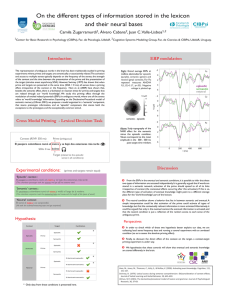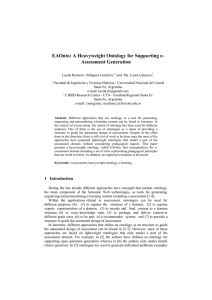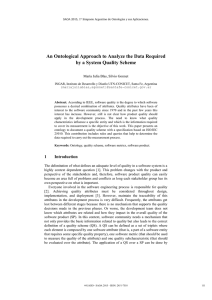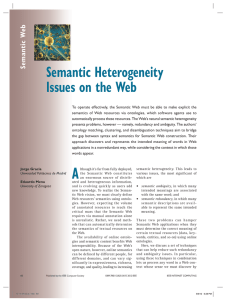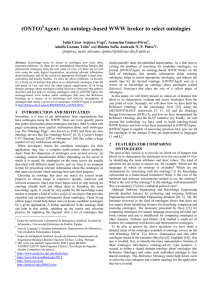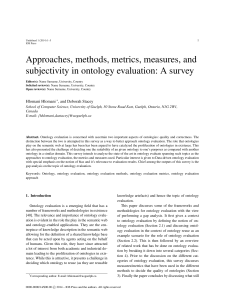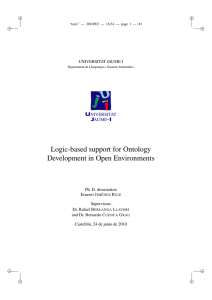A Framework for the Automatic Calculation of Quality of
Anuncio
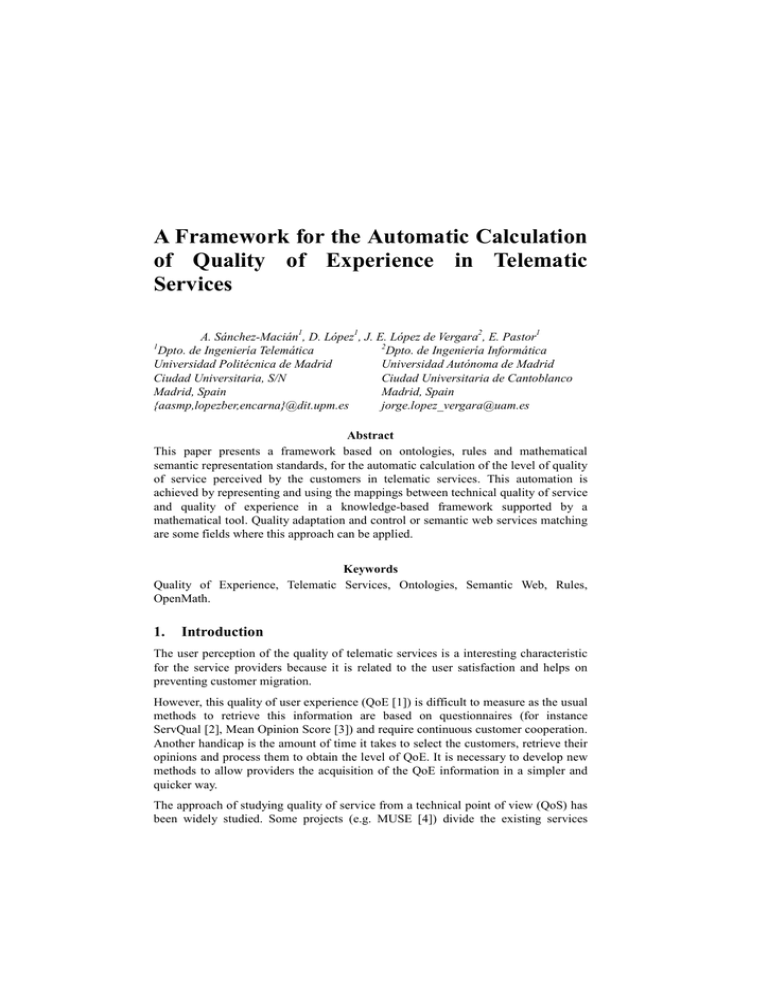
A Framework for the Automatic Calculation
of Quality of Experience in Telematic
Services
A. Sánchez-Macián1, D. López1, J. E. López de Vergara2, E. Pastor1
2
Dpto. de Ingeniería Telemática
Dpto. de Ingeniería Informática
Universidad Politécnica de Madrid
Universidad Autónoma de Madrid
Ciudad Universitaria, S/N
Ciudad Universitaria de Cantoblanco
Madrid, Spain
Madrid, Spain
{aasmp,lopezber,encarna}@dit.upm.es
jorge.lopez_vergara@uam.es
1
Abstract
This paper presents a framework based on ontologies, rules and mathematical
semantic representation standards, for the automatic calculation of the level of quality
of service perceived by the customers in telematic services. This automation is
achieved by representing and using the mappings between technical quality of service
and quality of experience in a knowledge-based framework supported by a
mathematical tool. Quality adaptation and control or semantic web services matching
are some fields where this approach can be applied.
Keywords
Quality of Experience, Telematic Services, Ontologies, Semantic Web, Rules,
OpenMath.
1.
Introduction
The user perception of the quality of telematic services is a interesting characteristic
for the service providers because it is related to the user satisfaction and helps on
preventing customer migration.
However, this quality of user experience (QoE [1]) is difficult to measure as the usual
methods to retrieve this information are based on questionnaires (for instance
ServQual [2], Mean Opinion Score [3]) and require continuous customer cooperation.
Another handicap is the amount of time it takes to select the customers, retrieve their
opinions and process them to obtain the level of QoE. It is necessary to develop new
methods to allow providers the acquisition of the QoE information in a simpler and
quicker way.
The approach of studying quality of service from a technical point of view (QoS) has
been widely studied. Some projects (e.g. MUSE [4]) divide the existing services
depending on their characteristics such as elastic/inelastic or interactive/noninteractive and assign QoS classes (such as the defined in G.1010 [5]) to each division.
Each one of these classes are related to a set of parameters and thresholds to be
controlled. The measurements of these parameters is made using existing tools (such
as Netflow [6]). Then, the information is gather through proprietary methods or using
RMON [7] (Remote Monitorization) based technologies.
Finding the relationship between these two quality of service domains, QoE and QoS,
may help in retrieving the QoE information in an automatic way. Some works have
been oriented to describe this mapping (e.g: E-Model [8] in telephony or [9] for video
delivery). The definition of these relationships is out of the scope of this paper.
Semantic web technologies, ontologies and rule languages, are open standards that
can help on exchanging QoS information and calculating QoE levels. QoS Ontologies
define a formalization of the QoS information to make easy the information
management. They help on sharing common understanding between people and
applications, enable reuse of domain knowledge and separate this kind of knowledge
from the operational one [10]. The use of rules provides a way of generating new
information depending on the collected data and even act upon the service
architecture components in an autonomic computing style.
This paper presents a framework based on ontologies and rules to perform the
mapping between QoS and QoE. First, an introduction to quality of experience and
quality of service is presented. The application of Semantic Web technologies to the
solution of this problem is also discussed. Later, a framework for the automatic
calculation of QoE is proposed. Finally, different alternatives for the representation of
the relationships between QoS and QoE are defined and compared.
2.
QoS, QoE and the Semantic Web
As explained before, the measurement of the technical component of quality of
service has been widely studied from a network and application point of view. The
metrics used to calculate technical QoS are based on monitoring objective
characteristics. The observed characteristics differ between services (or between
classes of services). The required data can be collected in an automatic way, using
available software.
However, there is a gap between this technical QoS based on objective characteristics
and the quality perceived by the users, the quality of experience (QoE), based on
subjective parameters. Traditional metrics to calculate QoE come from the Economy
field and are based on questionnaires. The use of these metrics makes the data
collection task time-consuming and requires manual operation.
The providers are interested in making the QoE acquisition process quick and
automatic. This goal can be fulfilled by mapping the technical quality of service to the
perceived quality. So, the relationship between both quality facets, sometimes called
utility function, has to be defined for each service.
Once the functions or formulas for the relationship are defined, the information has to
be collected and an application can process the information, apply the functions and
obtain the results. Traditional approaches are based on a specific development that
cope with a particular service.
As services in the Semantic Web can be a composition of other simpler services, it is
necessary to perform the QoS to QoE translation using a scalable and flexible
framework based on open technologies. Although this framework may be originally
tested with a reduced set of services and their quality relationships, it allows the
inclusion of new services in an easy way, only including service specific information.
This information is composed by the specific technical characteristics (e.g.: delay,
throughput, cpu load) and metrics (e.g.: mean delay) of a service and the function that
expresses the relationship between these technical characteristics and the QoE.
In the following it will be shown how ontologies contribute to make this scenario
feasible. The importance of the ontologies in the QoS field is supported by different
research papers that work on the creation of a quality of service ontology (e.g. [11]
and its application to use cases (unpublished [12]).
3.
Framework for QoE calculation
The proposed solution is based on knowledge-based technology. We opted to use the
languages defined in the Semantic Web initiative because our problem have in
common with this project the characteristics of distribution and data sharing. We
work on the creation of a framework capable of expressing the existing relationships
(functions or formulas) between the different domains and translating the quality level
between domains. Thus, combining the automatic calculation of the technical QoS
level and the inter-domain translation, it is possible to obtain the QoE level
automatically. This could be used for QoS adaptation or dynamic service selection.
Mathematical
App. API
Application
QoS Ontologies (OWL).
Classes and instances of
QoS characteristics
Builtins
QoS Formulas (OWL
instances):
Include a data attribute with a
definition of a formula in
OpenMath format (XML)
REASONER
QoS Rules (SWRL):
Locate OWL instances for
QoS Characteristics and a
formula to produce a QoS
result
OpenMath API
Mathematical
Application
QoS Instances of Perceived
QoS
Figure 1: Framework for QoE Calculation
The designed architecture (Figure 1) uses a modification of the quality of service
ontology models defined in [11] and instances of these ontologies. Next, the steps to
be followed are described.
First, the providers retrieve data from different sources, measuring network and
application characteristics by using standard metrics. There are tools that can help on
this issue, e.g. Netflow. The output is a set of measures.
Then, these measures are aggregated and used to generate instances of the quality of
service ontology. The formalization of the quality concepts clarifies which
information is necessary and how it should be used to create the instances. This
second point needs a programming interface to allow the automatic publication of the
ontology instances from the values previously measured. Some existing projects, such
as [13], provide interfaces to handle ontologies, appropriate for this purpose.
Later, a rule language is used to define the relationship, formulas or functions,
between the different quality domains. The main problem consists in defining a
method of expressing these relationships. If they are defined as analytical functions,
several approaches are possible. They are discussed in next section.
Finally, the designed framework, including a reasoner, will use these rules and the
instances of the ontology to generate new instances related to the QoE domain
providing information about QoE level.
4.
Representation of QoS-QoE relationship
There are several approaches for the semantic representation of the relationship
between the technical component of quality of service and the quality of experience.
An example of the functions to be defined could be the automatic calculation of the R
factor (and the Mean Opinion Score) in telephony based on the network parameters.
The first option for the semantic representation issue could be the use of classes,
individuals and data properties in the Web Ontology Language (OWL) to symbolize
the functions. The applications would be in charge of identifying the individuals to be
used in the function, and performing the operations ( e.g: addition, subtraction ).
The second option to represent the relationship is the use of a rule language such as
the Semantic Web Rule Language (SWRL). SWRL allows the definition of rules to
work with OWL ontologies and instances. It also includes a set of built-in atoms to
write basic mathematical operations, such as sum or power. If the measurement
values are available as ontology instances and the formula is defined as a rule, the
reasoner can generate the QoE level values automatically. The SWRL rule has to
identify the instances corresponding to the measured values (handling OWL
instances) and define the mathematical operations between these instances (using
built-ins).
There are two main problems. A high number of characteristics will make the rule too
long and difficult to understand and manage, even with a simple formula. Complex
mathematical operations (such as integrals) are not supported in SWRL.
To overcome these handicaps, a third approach is based on the combination of SWRL
rules and a language to represent the semantic of mathematical objects, such as
OpenMath [14]. SWRL is used to manage the OWL instances locating those required
in the formulas and OpenMath defines the mathematical functions. A binding
mechanism is used to identify which instance corresponds with each variable in the
function. The callback mechanisms implemented in the reasoners will help on setting
up a bridge between mathematical semantics and the Semantic Web world. This
solution can be applied to any problem that requires the representation and
application of mathematical functions in an ontology scenario.
To use this solution we have taken the following steps:
•
Creation of a specific SWRL builtin type (mathext) that states the need of
applying a mathematical formula defined in OpenMath to a set of instances.
•
Generation of a class (QoSFunction) and a property (hasOM) to hold the
OpenMath function. The value of the property is an OpenMath XML expression.
•
Use of a existing reasoner (e.g.: Bossam [15]) and interfaces to communicate
with a Mathematical tool and generate the results.
We recommend the use of this latter approach due to its flexibility in adding new
services. In fact, flexibility is the main advantage when comparing the whole
framework with other automatic approaches, such as PESQ (Perceptual Speech
Quality Measurement) for the user perception of quality in telephony. Regarding
performance, it depends on the reasoner and mathematical tool being selected.
5.
Conclusions
This paper has presented a framework for the automatic calculation of QoE based on
knowledge-based technology and values of technical QoS parameters. The
automation is performed thanks to the formalization of the information and the
representation of the relationship between QoS and QoE using rules and mathematical
semantics. The addition of a new service is simple as only its particular semantics
(characteristics and mathematical functions) have to be included in the system.
Future work is oriented to prove this framework in a more complex scenario. We have
decided to apply it to video delivery through multimedia streaming.
ACKNOWLEDGMENT
This work has been partially funded by the Spanish Ministry of Education and
Science under the projects VIDEORED (TIC2003-04406) and CASERTEL-NGN
(TSI2005-07306-C02-01).
References
[1] A. Moorsel, "Metrics for the Internet Age: Quality of Experience and Quality of
Business," in Fifth International Workshop on Performability Modeling of
Computer and Communication Systems, Erlangen, Germany, 2001, pp. 26-31.
[2] V. A. Zeithaml, A. Parasuraman, L. L. Berry, Delivering Quality Service.
Balancing Customer Perceptions and Expectations. New York. USA. The Free
Press. Macmillan, Inc., 1990
[3] Recommendation P.800.1 – Mean Opinion Score Terminology, ITU-T, Geneva,
Switzerland, 2003.
[4] A. J. Elizondo, “QoS Classes for BB access” in Broadband for All cluster and
QoS Workshop, Brussels, Belgium, 2005
[5] Recommendation G.1010 – End-user multimedia QoS categories, ITU-T, Geneva,
Switzerland, 2001.
[6] CISCO IOS Netflow
http://www.cisco.com/en/US/products/ps6601/products\_ios\_protocol\_group\_h
ome.html.
[7] Introduction to the Remote Monitoring (RMON) Family of MIB Modules (RFC
3577), IETF, 2003
[8] Recommendation G.107 – The E-model, a computational model for use in
transmission planning, ITU-T, Geneva, Switzerland, 2003.
[9] O. Verscheure, P. Frossard, M. Hamdi. “User-Oriented QoS Analysis in MPEG-2
Video Delivery”, Real Time Imaging, vol. 5, no. 5, pp. 305-314, Oct., 1999
[10] N. Noy, D. L. McGuinness, “Ontology Development 101: A Guide to Creating
Your First Ontology. Technical Report KSL-01-05, Stanford University, Stanford,
California, USA, 2001
[11] G. Dobson, R. Lock, I. Sommerville. “QoSOnt: a QoS Ontology for ServiceCentric System” in 31st EUROMICRO Conference on Software Engineering and
Advanced Applications, Porto, Portugal, 2005, pp. 80-87.
[12] A. Sánchez-Macián, J.E. López de Vergara, E.Pastor, L. Bellido, “A System for
Monitoring, Assessing and Certifying Quality of Service in Telematic Services.”
Submitted to Knowledge-Based Systems
[13] Jena, A Semantic Web Framework for Java. http://jena.sourceforge.net/
[14] OpenMath, http://www.openmath.org/cocoon/openmath/index.html
[15] M. Jang, J. Sohn, “Bossam: an extended rule engine for the web”, Lecture Notes
in Computer Science, vol. 3323, pp 128-138, Nov, 2004



